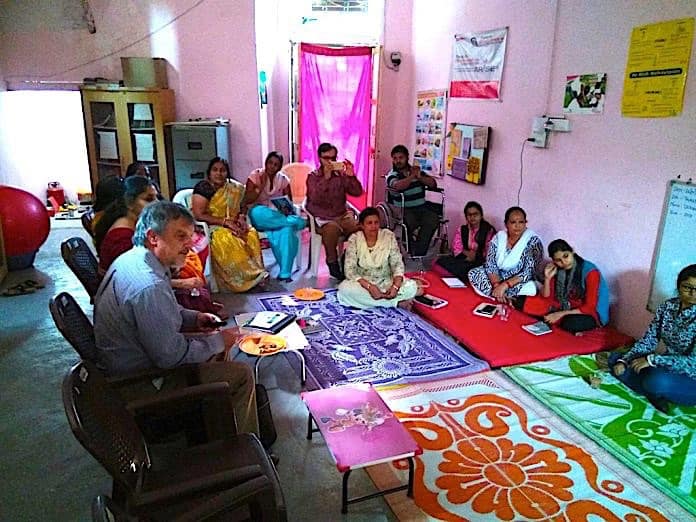It’s 5 a.m. and Vihaan is slowly waking up. He usually gets up by 6 a.m. so his mom can get him ready for the long journey to school. But this morning things are a little bit different. The weather forecast predicts some rain later this morning. If that occurs, there’s no way Vihaan Is going to get to school. But maybe if he can get ready by 5:30 his mom will feel comfortable carrying him to school through dirty narrow streets of the slum, before the rain turns them to mud.
The only way that Vihaan can get to school is quite literally on his mom’s back. If mom is ill he has no other way to get to school. There is no school bus provided by his school. Vihaan’s mother can’t afford a taxi (by auto-rickshaw.) Even a bicycle won’t work because Vihaan has Cerebral Palsy and isn’t capable of pedaling. Certainly, there is not enough money to get him an adapted piece of equipment like a hand-motivated bicycle. In essence, Vihaan is facing an access problem that is going to get worse as he grows older. His mom can barely carry him now, so when he gets a little bit bigger he probably won’t be able to go to school.
He will end up being like thousands of students with disabilities in India. Although there are a few special schools for students like Vihaan, almost all of them require the student to have their own arranged transport. There are government schools which are legally obligated to accept students like Vihaan, but they don’t even have enough resources to provide all the students with necessary supplies, let alone accessible transportation.
Vihaan goes to a community school run by an NGO (non-governmental organization) which focuses on students like him. None of the students ride a school vehicle or a public bus. None of the teachers ride to school either. Many of the teachers started as volunteers at the school and once they had learned the basics of teaching, they were “drafted” into the job. The funding for each of their positions is carefully managed by their principal, Radhika. Frequently, the group has to choose between teaching material and a teacher’s salary. But somehow, they always manage. Nobody really knows how year-after-year the school survives but many suspect it has something to do with Radhika’s family wealth and connections.
I visited India to accept and participate in the release of the Hindi translation of our guide Bridging the Gap: Your role in transporting students with disabilities in developing countries from Svayam.* Svayam, led by Sminu Jindal, has done a great job translating our guide into a document that can be used by many educators and school leaders to improve access in India. The traffic on the way makes the length of the trip almost unbearable. However, I soon forgot about the traffic as I became immersed in sharing with so many passionate educators. It’s especially gratifying when they are so interested in how we do things despite their obvious lack of resources. We see a short professional looking video highlighting the benefits of the school. Many of the staff, some sitting on the floor, star in this movie.
Radhika’s team really cares for the students so they were very honored when we came to teach them about Bus In the Classroom. After a 1.5 hour long meeting, presentation and questions, they are already hard at work figuring out which skills they will teach to the students. They even hold out hope of buying an auto rickshaw with money from a grant that I mentioned. That vehicle, they calculate, will allow numerous students to attend even if a few are late because they didn’t fit on the first run. I’m careful not to mislead them because I can’t guarantee that they’ll get the grant. Somehow, though, I’m pretty sure this group will figure out a way to win.
The picture really isn’t pretty for students with disabilities in much of India. If we can teach the students independent mobility skills appropriately, maybe a few of them can access education by public transit. Maybe a few more can learn to navigate their “streets.” Without major infrastructure changes though, students with disabilities cannot count on accessing the classroom. For parents of these students, the only hope is to pursue some of the strategies collected in our guide. Maybe a group of parents can share costs for an auto-rickshaw (Tuk-Tuk) or parents can organize a version of the walking school bus. There are many more options collected and explained in Bridging the Gap. It would be truly wonderful to visit Vihaan years from now and see what a creative and successful person he is because of the difference we made. If our guide helps, all the better!
• Svayam is an initiative of the Sminu Jindal Charitable Trust, based in New Delhi, that works to promote the dignity of people with reduced mobility and advocates for an enabling and accessible environment for all. They sponsored my visit.
• The Bridging the Gap guide is downloadable for free at www.globalride-sf.org. Its Hindi version will soon be available at svayam.com for free in the Resources Section.

Meslin is the director of transportation for Newport-Mesa Unified School District and an editorial advisor to School Transportation News. He can be contacted at pete.meslin@gmail.com.


















